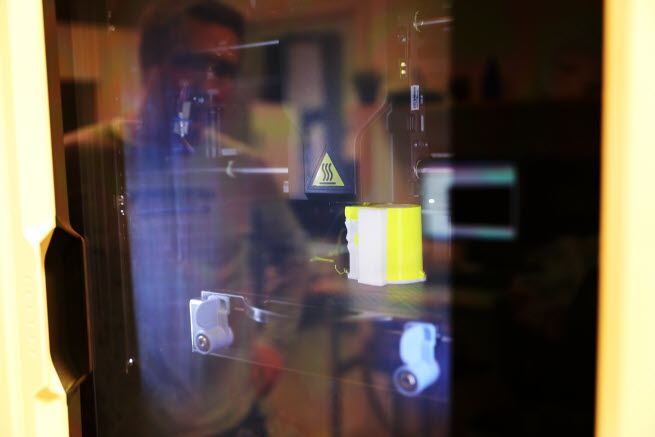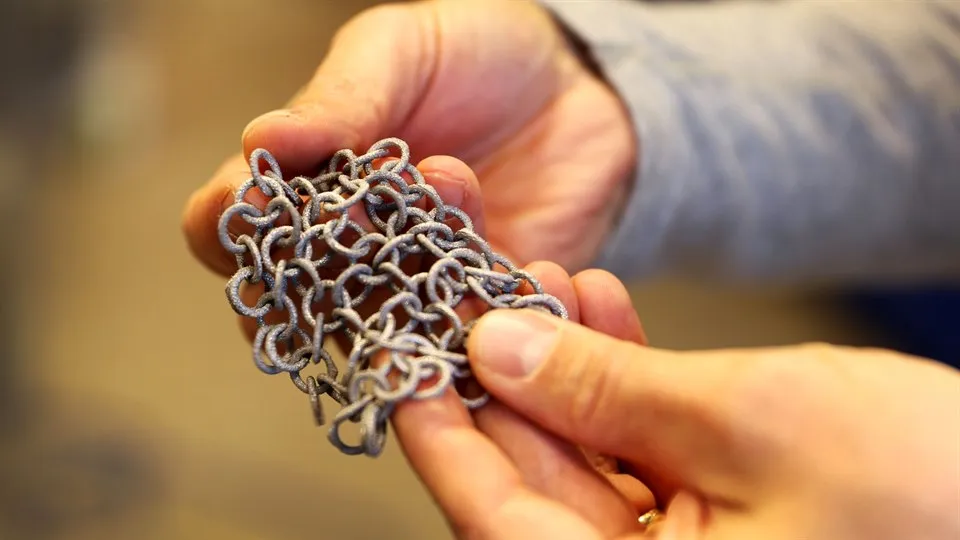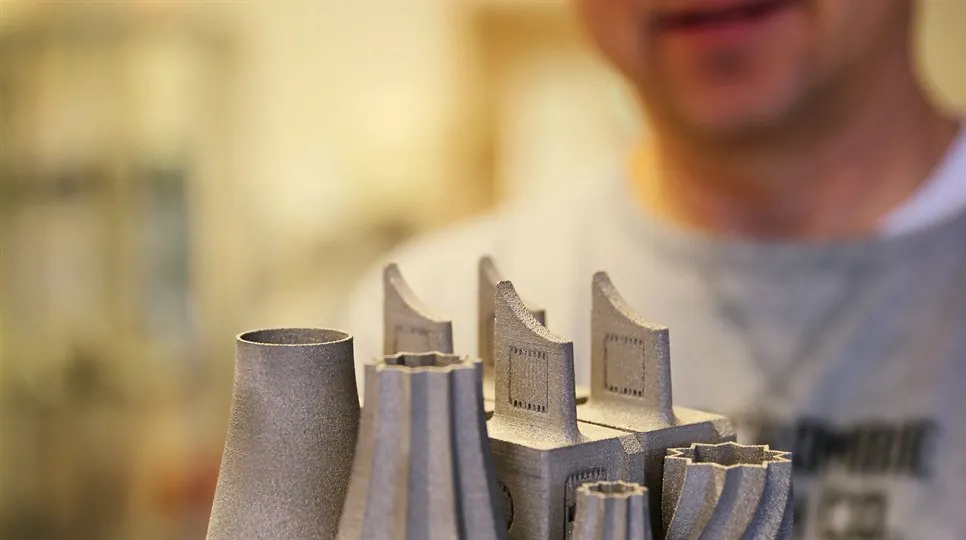3D‑printing for the future
Ten years ago, Mid Sweden University acquired a 3D-printer for SEK 7 million. It provided researchers with unique opportunities and an advantage over the rest of the world that continues to this day.
A miniature ship, a ball within a ball, a toy car. The plastic items are gathered together on a table, all created by one of the advanced 3D-printers that stands in the Sports Techs lab at the Östersund campus. Mid Sweden University now has several such printers, with another five examples, for example, standing in a row in a study room further down the corridor. All students who study mechanical engineering or sports technology have free access to the printers, and they are able to print out any 3D models that they have designed or which they have found for free on the Internet.
There is no longer anything unusual or particularly amazing in printing out items in 3D.
“I have been giving lectures on additive manufacturing and 3D-printing for almost 15 years. Up until ten years ago, most attendants at my lectures didn't have an idea what I was talking about. If I were to ask the same question now, everyone would put their hand up", says Lars-Erik Rännar, university lecturer and associate professor in mechanical engineering, specialising in additive manufacturing.
The machine he is standing next to is as big as an old-fashioned safe, with the glass panel in the lid providing a glimpse of what is happening inside. A prototype of a flow switch is currently being printed out in grey and yellow plastic. Additive manufacturing can be described as the process of building something up layer by layer. A glue gun is slowly but steadily squeezing out plastic in layers – rather like a cheese slicer cutting thin slices, but in reverse.
It takes about five hours to print out the prototype.
“It's hard to say how much it costs to print out something like this, if you try to work out the hourly cost against the cost of the machine and so on. I would say that the material costs less than 40 kronor though.”
A technology that is gaining ground
Lars-Erik Rännar started at Mid Sweden University in 1998 and got into additive manufacturing when he started his research studies in Trondheim in 2000. He worked on producing tools for the injection moulding industry, and an important question for the industry was finding techniques for rapid cooling-down. Lars-Erik Rännar researched into how to make curved cooling channels.
“The geometries are complex, and if you could produce curved cooling channels, it would also allow rapid cooling down of the metal inserts they manufactured. High heat conductivity is important – if there is poor cooling, it just won't work.”
The technology, which was known at the time as rapid prototyping, was still in its infancy at the start of the century, especially in metal. As a result of his research, Lars-Erik Rännar got to hear about a company in Sweden, Arcam in Mölndal, that was working on rapid prototyping and that had built a prototype machine that could create metal inserts with curved cooling channels. Rännar started to work with them.
“Once I got to hold the first model and saw that it worked, it very clearly awoke an interest".
Rapid Prototyping eventually came to be called 3D printing. Now, 17 years later, people can buy their own 3D printers at Clas Ohlson or Teknikmagasinet. A few years ago, Arcam in Mölndal was sold to the American company General Electric, GE. The purchase price came in at SEK 4.5 billion.
The bear's tooth became a printer
Lars-Erik Rännar and his research team really wanted a machine of their own similar to the one built by Arcam, but they did not have the money. When the armed forces closed down their operation in Östersund, the county government board in Jämtland was allocated a few million in transition funding to be distributed to companies and projects. For a few years there were plans to build a hotel and conference facility at the top of Frösöberget, a project called Björntanden – the Bear's Tooth. However, the project came to nothing, which is when the researchers at Mid Sweden University saw their chance.
“There was money left in the pot of transition funding, and with just a month left, we submitted an application to the county government board in order to be able to buy a machine. And they said yes.”
It cost SEK 7 million – the first 3D printer acquired by Mid Sweden University. It was the size of a double fridge and it took up almost a whole wall in the Sports Tech lab, and now, ten years later, it is still being used to print out advanced metal objects. When it was bought in 2007 it was the first of its kind in north Europe, and there were just ten like it in the whole world.

From metal to plastic to new discoveries
While researchers were now able to use the machine to develop advanced metal products for industries, a start had also been made on other paths in additive manufacturing. 2003 saw the purchase of the first plastic printer, and before long a collaboration was started with the orthopaedics department at Östersund hospital. By being able to print out advanced bone fractures based on X-ray plates, the researchers were ab le to help the orthopaedists to get a clearer idea of how to operate.
“We created an accurate copy of what it looked like, how a bone fracture looks. By turning it around and feeling it, the surgeons were better able to plan the operation”, explains Lars-Erik Rännar.
This then prompted the thought of a further development.
“We then thought, what if we could manufacture implants for patients?”
They could, and now research has advanced to the point at which 3D machines are used to print out titanium parts that are then surgically implanted into human patients.
In 2009, Mid Sweden University was certified by Arcam to work on process and material development. Developing new materials is now one of the largest challenges facing researchers. Titanium is one of six metals that can be bought for use in additive manufacturing, and in fact there are very few materials that are not now available for the technology.
“3D-printed titanium is now being used, and examples can be found in both aircraft and patients. It is very light, there is little material wastage as the process uses only what is required for the finished product, and it is extremely strong.”
Researchers at Mid Sweden University have now developed a new material, 316, a type of stainless steel that is used in the construction industry and which is much cheaper than titanium. The project for finding a new material has been conducted in collaboration with several other universities and with funds from sources including the international Fusion for Energy project, which aims to solve the energy needs of the future.
“The next step is to commercialise this, and then to see if there is any interest in the market”, says Lars-Erik Rännar.
He mentions everything from the pharmaceutical, tool and processing industries to the energy sector as being potential sources of interest in additive manufacturing using 316. In order to be able to work commercially with questions of this kind, the company AIM, Additive Innovation and Manufacturing, has been created, with its head office at Frösön. Mid Sweden University is one of the joint owners, and Lars-Erik Rännar is doing some work at the company.
Focusing on sustainability
The mechanical engineers at Mid Sweden University gained a real lead on the rest of the world when they were given the opportunity to buy their incredibly expensive 3D printer. It is an advantage that they have used to process-develop and identify new materials.
“There is still so much to be done, and we have an enormous advantage. We were given a great opportunity ten years ago, and we have to exploit the expertise that we have”, says Lars-Erik, adding jokingly:
“I'm 44 years old, so I have a lot of years left here.”
At the same time as additive manufacturing technology is taking giant steps forward, it is also important to develop the technology from a sustainable perspective. The effort by the team of researchers at Mid Sweden University to find new materials raises the importance of issues such as consumption of energy and materials. Metal is a material that generates little production waste, but the energy consumed leaves some room for improvement.
“It's also a matter of identifying the right application areas, so that we can really do some good and concentrate our efforts where we can make a difference.”
From a sustainable economic perspective, according to Lars-Erik Rännar, using 316 means that they are on the right track. With the technology advancing so rapidly, it is natural to ask where 3D printing will be in another 15 years. Will the 3D printer become as common a household object as an Ipad or a microwave oven? Lars-Erik Rännar does not think so.
“No. As has already been said, you can buy a 3D printer in the shops now, but the technology is advancing so quickly that loads of machines are being released every year. Take the photo printer for example: what's the point of using your own photo printer to print out photos when it's so cheap and easy to order them on line. As for 3D printing, I think people will order what they want from someone with the latest technology just by sending in a drawing.”
While the ordinary consumer may derive considerable joy from the plastic items that 3D printers are printing out at an ever-increasing rate, Lars-Erik Rännar thinks that the major developments in the future will take place primarily within industry.
“That's where you can lower costs and shorten production stages. At the same time, however, not as much is being invested here in Sweden as in Germany, for example. It's important to talk about the technology in Sweden, and as a university, we have a responsibility in this respect.”

